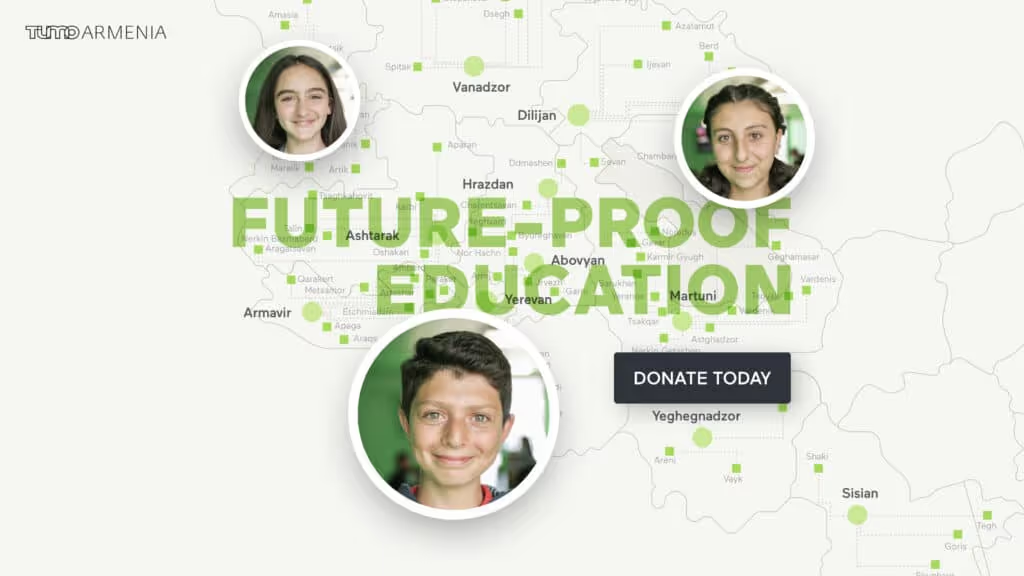An Ultimate Guide to Creating Fundraising CTAs + 12 Examples

Categories
Publish Date
Services
Share

Ready to Take Your Nonprofit Marketing to the Next Level?
Book time with our team and we'll get in touch.
In the dynamic world of online fundraising, a well-crafted Call to Action (CTA) is the keystone of success. At Fifty & Fifty, we understand that the heart of any effective fundraising campaign that will improve your chances of reaching your audience lies in a carefully developed and executed strategy.In this blog post, we'll delve into the fundamentals of crafting compelling CTAs that resonate with your nonprofit target audience, drive engagement, and boost conversions. We’ll also explore the essential elements of a successful fundraising campaign and learn why strategic calls to action are indispensable in capturing attention and inspiring meaningful action in support of your cause.
Fundraising CTAs FAQs
What are fundraising CTAs?
A CTA is a prompt that motivates potential donors to take a specific action, such as donating, signing up for newsletters, or sharing your cause. It's a key element in fundraising strategy to drive engagement and support.
Why are fundraising CTAs so important to nonprofits?
A compelling CTA sparks action. It guides donors in their steps, creating a transparent and effortless process for them to contribute to your cause. A straightforward and persuasive CTA can significantly increase conversion rates and overall campaign success. The average click-through rate for nonprofits is 3%, while the average open rate is 26% and donation page conversion rate is 17% – so you can see why it’s important to optimize your CTAs!
What types of fundraising CTAs are there?
There are multiple types of fundraising CTAs, and each one can be utilized in different situations to maximize your potential outcome.
- First-Time Donation CTA: A First-time Donation Call to Action (CTA) is designed to specifically target individuals who have not yet contributed to a nonprofit organization. The goal is to encourage these potential donors to make their initial contribution and become supporters of the cause.
- Lapsed Donor Reengagement CTA: A Lapsed Donor Reengagement Call to Action (CTA) is a strategy to reconnect with individuals who have supported your organization in the past but have not contributed recently.
- Fundraising Event RSVP CTA: A Fundraising Event RSVP (Response/Confirmation) Call to Action (CTA) encourages individuals to confirm their attendance at a specific fundraising event organized by a nonprofit organization. The goal is to maximize attendance, engage supporters, and facilitate planning for the event.
- Recurring Giving Club CTA: A Recurring Giving Club Call to Action (CTA) encourages donors to commit to making regular, ongoing contributions at scheduled intervals, typically monthly or annually. The goal is to establish a group of dedicated supporters who contribute regularly, forming the foundation for sustained, predictable funding.
What are some good examples of fundraising CTAs?
Get inspired by these 12 CTA examples by understanding what they do well:
- "Transform Lives Today: Donate Now!" This CTA emphasizes the immediate impact of the donor's contribution and uses dynamic language to convey the transformative nature of their support.
- "Be a Hero – Support Our Cause!" Positioning donors as heroes resonates emotionally. This CTA inspires a sense of empowerment and importance in contributing to a noble cause.
- "Give the Gift of Hope: Donate Today!" Appeals to the emotional aspect of giving, framing the act of donation as a gift that brings hope to those in need.
- "Join the Movement for Change – Contribute Now!" Framing the act of giving as part of a broader movement for positive change adds a sense of community and purpose to the CTA.
- "Empower Tomorrow: Set Up a Monthly Donation!" Encourages recurring giving by highlighting the long-term impact of regular contributions in empowering the organization's future initiatives.
- "Invest in a Brighter Future – Make Your Contribution!" Framing the donation as an investment emphasizes the lasting and positive effects that the donor's contribution will have on the future.
- "Unlock Potential: Support Education for Every Child!" Connects the act of giving with unlocking potential, specifically focusing on the impact on children's education.
- "Give the Gift of Clean Water: Donate Today!" Targets a specific cause (clean water) and emphasizes the idea of giving as a gift, making the CTA more tangible and relatable.
- "Stand with Us: Support [Campaign Name] Now!" Calls for solidarity by inviting donors to stand with the organization and support a specific campaign, creating a sense of unity and purpose.
- "Rescue, Rebuild, Restore: Your Donation Makes a Difference!" Highlights the three Rs (Rescue, Rebuild, Restore) to communicate the comprehensive impact of the donor's contribution in addressing various aspects of a cause.
- "Give the Gift of Healing: Help Us Save Lives!" Appeals to the donor's desire to make a meaningful impact by emphasizing the gift of healing and the life-saving potential of their donation.
How can a nonprofit marketing agency help with crafting fundraising CTAs?
A nonprofit marketing agency can set you apart from your competitors and further cement your organization’s reputation. Marketing your organization will connect you with interested benefactors and shape the change you want to achieve, including crafting compelling fundraising CTAs. None of this can happen without a strong partnership—a truly collaborative client/agency relationship.

Fundraising CTA Do's and Don'ts
DO:
-
- Be direct about your intended next action: A clear, concise direction can help ease the process for potential donors and prevent confusion or loss of interest.
- Segment your audience: By speaking directly to your different audiences, you can optimize your chances of connection and follow-through. Knowing your target audience persona(s) and writing specific appeals for each segment can help with this.
- Highlight tangible impact: Sharing the tangible impact their donation will make can encourage potential donors to make it to the finish line with their generosity. For example, an animal shelter might highlight that a $50 donation can provide 30 meals for foster dogs this month.
- Keep it simple: Creating too many elements or highlighting too many facts can confuse your potential donors. Choose a few beneficiary stories to highlight so your message isn’t muddled.
- Consider web accessibility best practices: Making your mission, vision, and fundraising CTAs accessible to all, regardless of ability and browsing preference, is key to broadening your impact. For instance, ensure that digital materials are mobile-friendly and accessible by using alt text and color contrast. Also, consider offering translated versions of your website so speakers of other languages can be inspired by your content.
- Ensure clarity: Use concise and straightforward language to get the desired action. Having a clear brand for your nonprofit can help you establish this language throughout your campaigns.
- Use Data-Driven Insights: Use insights that help tap your potential nonprofit donor audience more effectively.
-
DON’T:
- Rely on jargon: Part of making your mission and vision accessible is to use terminology that everyone can understand, regardless of education or profession. Use simple, emotional terms to discuss your mission-critical initiatives.
- Be too generic: Get personal with your CTAs! Personalized CTAs perform over 200% better than general CTAs.
- Pressure the reader: While you should encourage prompt responses by incorporating time-sensitive language, don’t add too much pressure on the reader.
- Use negative imagery: Share the impact of giving and the difference it’s making, but don’t guilt-trip the potential donors with too heavy of information.
- Overwhelm with choices: Keep the choices clear and straightforward so potential donors know where to go next.

4 Tips to Level Up Your Fundraising CTAs
1. Pay attention to placement.
Placement. The placement of your CTAs impacts who will see and interact with them. To optimize your outcome, we recommend:
- Placing high-priority CTAs above the fold on online content, in email subject lines, and as the first slide in a social media post so they get more attention
- Flashing a pop-up CTA one time on the pageEnsuring the CTAs display as the right size on all types of browsers and at all places on the page
Tip: Once you’ve optimized placement, the next step is ensuring your email and social media strategies are designed to drive engagement. Discover best practices for nonprofit email outreach in our Email Marketing Guide for Nonprofits and explore how to maintain a strong brand presence across platforms in our Social Media for Nonprofit guide.
2. Prioritize branding and visuals.
Creating CTAs that are visually appealing and eye-catching can make all the difference in click-through rates. Nonprofit branding is an art, and having unique visual brand elements can be your key.
3. Choose the right partners.
Working with a digital agency for nonprofits and social brands (such as Fifty & Fifty!) can provide more comprehensive strategy recommendations tailored to your mission, vision, and values.
4. Collect feedback.
By outlining your key performance indicators (KPIs) during the planning process, you can start tracking them earlier and get a more complete dataset. You can enhance this potential for feedback by including A/B testing and supporter surveys.
Case Study: Successful Fundraising CTAs

Fifty & Fifty had the privilege of working with TUMO Armenia on a campaign that included the use of successful fundraising CTAs.We determined that a wide array of sources would be necessary in order to reach the ambitious $10 million fundraising goal that TUMO came to us with, which included donors with both large and small gifts, corporate partners, and more.We approached the campaign by creating a digital experience that included an online experience allowing donors to understand the mission, sponsor specific locations through an interactive map, and receive a special gift directly from the teens they support. The fundraising CTAs we used were clear, concise, and targeted at the appropriate audiences for the appropriate response and resulted in 19M+ raised around the world, and more than 50 Education Hubs Funded.The campaign produced widespread engagement in the Armenian community, engaged influential partners, and thanks to a powerful integration with Donately, is continuing to push fundraising efforts above and beyond the initial goal.Want to see more inspiring nonprofit campaigns? Explore our Best 16 Nonprofit Marketing Campaigns to learn how top organizations have successfully executed marketing strategies that drive impact.
Wrapping Up
Whether exploring the importance of strategic CTAs or unraveling the nuances of distinct types, we've aimed to empower your fundraising initiatives with knowledge and actionable insights.As you harness the full potential of your fundraising campaigns, leverage these Fundraising CTA FAQs, Dos and Don'ts, and tips to optimize your CTAs.Even if you’ve got the basics covered, remember that our team stands ready to collaborate with you, providing comprehensive strategy recommendations and leveraging our expertise to amplify the impact of your mission.Here's to unlocking the full potential of your fundraising endeavors and propelling your nonprofit's vision to new heights.
Additional Resources
- Nonprofit Marketing Plan 2025: Steps, Templates & Examples. Setting a firm foundation for your marketing efforts allows you to launch your campaign effectively and gauge progress. Explore our guide to making a nonprofit marketing plan.
- Influencer Marketing for Nonprofits: Practical Tips, Examples, Templates & Checklist. Amplify your fundraising efforts by partnering with influencers who resonate with your mission.
- Nonprofit Budget 2025: Steps, Planning, Examples & Template. Learn how to allocate resources wisely to support impactful campaigns and maximize donor contributions.
- Nonprofit Digital Marketing – Making Your Mark Online. Learn the ins and outs of the future of digital marketing for nonprofits in this guide.
Have a project or idea?
We believe in the hard work people are doing to address the world's most pressing problems. Every day, our agency fights to turn visions of social change into concrete realities.






